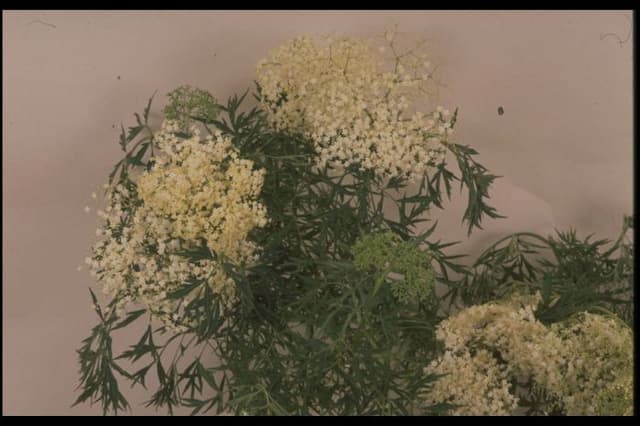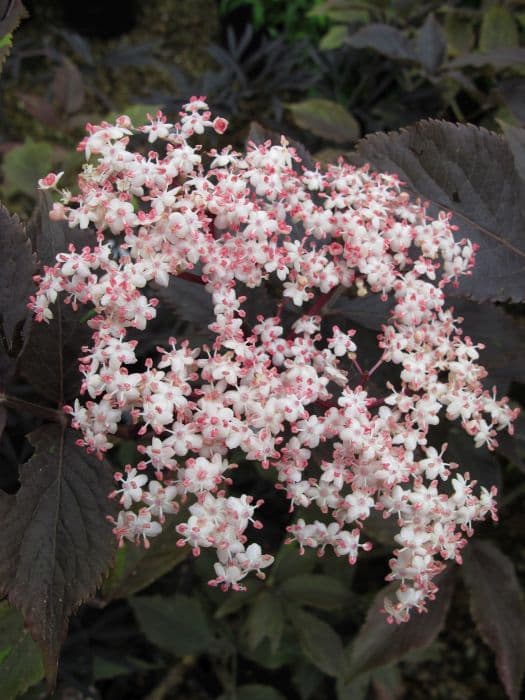Red Elderberry Sambucus racemosa 'Sutherland Gold'

ABOUT
Sutherland Gold elderberry is a striking plant known for its vibrant foliage and ornamental qualities. The leaves are one of its most distinctive features, with a bright golden-yellow color that can add a luminous quality to any garden setting. These leaves are compound, with multiple leaflets on each leaf stem, which gives them a feathery, delicate appearance. The plant blooms in the spring, producing clusters of tiny, creamy white flowers that can be quite fragrant. These flowers are attractive to pollinators like bees and butterflies, adding an additional layer of activity and interest to the plant. In late summer, the flowers give way to small red berries that are popular with birds and other wildlife, though they should not be eaten by humans as they are considered toxic. Sutherland Gold elderberry has a bushy and sprawling growth habit, which can make it an excellent choice for filling in garden spaces and creating textured backdrops for other plants. Its overall form is somewhat irregular, adding to its natural and wild appearance. Throughout the seasons, this plant maintains its visual interest, with foliage that may turn more greenish in the heat of summer and then develop richer, red-tinged tones in the fall before shedding its leaves for winter dormancy.
About this plant
 Names
NamesFamily
Adoxaceae
Synonyms
Red Elderberry, Sutherland Gold Elderberry, Golden Elderberry
Common names
Sambucus racemosa var. racemosa, Sambucus racemosa var. arborescens, Sambucus racemosa var. melanocarpa, Sambucus racemosa var. microbotrys, Sambucus racemosa var. sieboldiana, Sambucus racemosa ssp. pubens, Sambucus racemosa var. leptocarpa, Sambucus racemosa var. typica.
 Characteristics
CharacteristicsLife cycle
Perennials
Foliage type
Deciduous
Color of leaves
Golden
Flower color
White
Height
6-10 feet (1.8-3 meters)
Spread
6-10 feet (1.8-3 meters)
Plant type
Shrub
Hardiness zones
3-7
Native area
Europe
Benefits
 General Benefits
General Benefits- Attractive Foliage: 'Sutherland Gold' Elderberry has chartreuse to golden-yellow leaves that can brighten up a garden space.
- Wildlife Habitat: It provides food and shelter for birds and other wildlife.
- Easy to Grow: This plant is robust and adaptable, making it suitable for gardeners of all skill levels.
- Landscape Design: With its striking foliage, it can serve as a focal point or background plant in landscape designs.
- Pollinator Friendly: It attracts bees, butterflies, and other pollinators, which are vital for a healthy ecosystem.
 Medical Properties
Medical Properties- Immune Support: Sambucus racemosa, commonly known as Red Elderberry, contains compounds that may bolster the immune system.
- Antioxidant Activity: Components found in Red Elderberry possess antioxidant properties that help protect cells from oxidative damage.
- Anti-Inflammatory Effects: Red Elderberry has traditionally been used to reduce inflammation, though scientific evidence for this use is limited.
- Diuretic Action: The plant has been used to promote urine production and fluid release from the body.
- Laxative Properties: Red Elderberry is said to have a mild laxative effect, which could be utilized to alleviate constipation.
 Air-purifying Qualities
Air-purifying QualitiesThis plant is not specifically known for air purifying qualities.
 Other Uses
Other Uses- Companion planting: Elders like 'Sutherland Gold' are great for companion planting as they can help to deter pests from more sensitive plants.
- Wildlife garden: The plant attracts birds and butterflies, making it an ideal choice for those looking to create a wildlife-friendly garden.
- Photography: The striking foliage of 'Sutherland Gold' can serve as an exceptional backdrop for garden photography.
- Dye production: Historically, parts of the elder plant have been used to produce natural dyes for fabrics.
- Fruit pectin source: The fruits, when appropriate species are used, are high in pectin, making them suitable for homemade jam and jelly making.
- Educational tool: 'Sutherland Gold' can be used in educational settings to teach about plant life cycles and horticulture.
- Landscape design: The contrasting golden leaves can be used by landscape architects to create stunning color contrasts in gardens and parks.
- Erosion control: Elder plants can be utilized in areas prone to erosion to help stabilize soil with their root systems.
- Traditional crafts: The wood of elder plants has been used in traditional crafts like making small tools or instruments.
- Floral arrangements: Branches of 'Sutherland Gold' can be used in floral arrangements for their ornamental value.
Interesting Facts
 Feng Shui
Feng ShuiThe Red Elderberry is not used in Feng Shui practice.
 Zodiac Sign Compitability
Zodiac Sign CompitabilityThe Red Elderberry is not used in astrology practice.
 Plant Symbolism
Plant Symbolism- Regeneration and Renewal: The Elder, including the variety Sutherland Gold, often symbolizes regeneration and renewal because of its ability to quickly grow back even after being cut down to the stump.
- Protection: In folklore, the Elder tree is believed to ward off evil spirits. Planting an Elder near one's home was thought to offer the inhabitants protection.
- Prosperity and Abundance: Elder flowers and berries have historically been associated with prosperity and abundance due to their multitude of uses ranging from medicinal to culinary.
- Transformation and Death: With its associations to the ancient goddesses of life and death, the Elder tree also represents transformation, the cycle of life, and is sometimes connected with the afterlife in various cultures.
- Health and Wellness: Due to its medicinal qualities, the Elder symbolizes health and wellness. Elderberries, in particular, are renowned for their immune-boosting properties.
 Water
WaterThe Sutherland Gold Elderberry prefers consistently moist soil, so water it deeply once a week, providing about 1 to 1.5 gallons per watering, adjusting for rainfall. During hot, dry periods, increase the frequency to twice a week. Ensure the water penetrates the soil to reach the roots rather than just wetting the surface. It's best to water in the morning to allow moisture to evaporate from the leaves and reduce the risk of fungal diseases. Establish a regular watering schedule and monitor the plant's response, cutting back during the rainy season to prevent waterlogging.
 Light
LightThe Sutherland Gold Elderberry thrives in full sun to partial shade. It should be planted in a location where it receives at least 4 to 6 hours of direct sunlight per day for optimal growth and foliage color. Areas with dappled afternoon shade can be beneficial in regions with very hot summers, preventing the leaves from scorching.
 Temperature
TemperatureThe Sutherland Gold Elderberry can tolerate a wide range of temperatures and is hardy in USDA zones 4 through 7. It can withstand winter temperatures as low as -30°F and summer temperatures over 100°F. However, its ideal growing temperature is between 60°F and 70°F. Avoid placing it in areas where temperatures dip below its cold-hardiness zone to prevent frost damage.
 Pruning
PruningPruning is essential for the Sutherland Gold Elderberry to maintain shape, encourage bushiness, and remove any dead or diseased wood. Prune the plant in late winter or early spring before new growth starts. Annually removing about a third of the oldest stems at ground level can rejuvenate the plant. The best time for more formative pruning to shape the shrub is after it has finished flowering.
 Cleaning
CleaningAs needed
 Soil
SoilElderberry 'Sutherland Gold' thrives in well-draining soil rich in organic matter with a soil pH between 5.5 and 6.5. A mix consisting of loamy garden soil, compost, and a small amount of sand or perlite to enhance drainage should support healthy growth. Regular mulching can also benefit soil moisture and texture.
 Repotting
RepottingElderberry 'Sutherland Gold' does not typically require frequent repotting as it is commonly grown outdoors and develops a large root system. If grown in containers, young plants may need repotting every couple of years, but mature plants can go longer unless they show signs of being root-bound.
 Humidity & Misting
Humidity & MistingElderberry 'Sutherland Gold' is tolerant of a wide range of humidity levels but prefers conditions similar to its native environment, which is typically moderate to high humidity. It grows best outdoors where the natural humidity supports its needs.
 Suitable locations
Suitable locationsIndoor
Ensure bright, indirect light and ample space for growth.
Outdoor
Plant in partial shade, mulch well, and protect from strong winds.
Hardiness zone
4-7 USDA
 Life cycle
Life cycleThe 'Sutherland Gold' Elderberry, a cultivar of Sambucus racemosa, begins its life cycle when a seed germinates in moist soil in spring, after which a seedling emerges. As a fast-growing plant, it quickly develops into a young shrub with compound, feather-like golden leaves and begins to establish a root system. During its vegetative stage, it grows vigorously through the spring and summer, with ample sunlight and water promoting strong stem and leaf growth. By its second or third year, the Sutherland Gold Elderberry reaches maturity and begins to flower, producing clusters of white-to-cream flowers that are attractive to pollinators and eventually give way to red berry clusters in late summer to fall. After fruiting, the plant enters a period of dormancy during the winter months, losing its leaves and conserving energy. With the return of warmer weather in spring, the cycle repeats, with new growth resuming and the plant continuing to mature and propagate either by seed dispersal or vegetative cuttings taken by gardeners.
 Propogation
PropogationPropogation time
Early Spring
For the Sutherland Gold Elderberry, which is a cultivated variety of Sambucus racemosa, the most popular method of propagation is softwood cuttings. This technique is typically performed in late spring or early summer, when the plant’s new growth is just beginning to mature and harden slightly. Cuttings should be taken from healthy, disease-free plants, selecting stems that are about pencil thickness and 4 to 6 inches long (approximately 10 to 15 cm). The lower leaves are removed, and the base of the cuttings is dipped in a rooting hormone to encourage root development. Cuttings are then placed in a well-draining potting mix or a propagation tray, and kept in a humid environment with plenty of indirect light until roots have formed, which usually takes a few weeks. After rooting, the new plants can be gradually acclimatized to outdoor conditions and finally transplanted to their permanent location in the garden.









